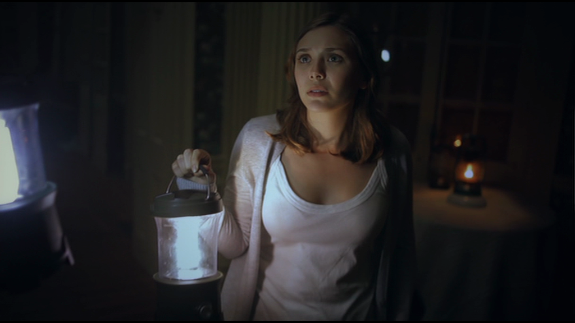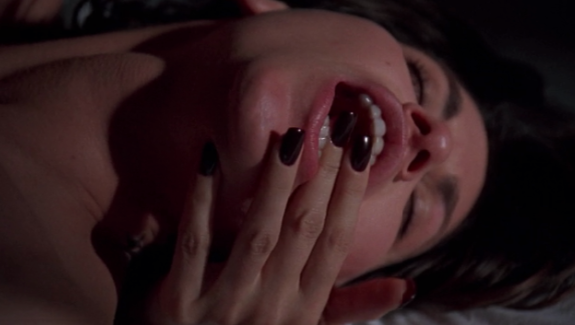
Gustavo Hernández’s low-budget Uruguayan horror film La Casa Muda (2011) stands out for two novelties: it’s based on real life grisly events and was made to appear as if it was shot in one continuous take. While the first has a salacious appeal, it’s the latter formal element that becomes suggestive of something far more compelling than a showy gimmick. Unfolding in real time—or as its tagline suggests, “real fear in real time”—the camera follows a young woman, Laura (Florencia Colucci), as she and her father (Gustavo Alonso) revisit their family’s old house to make renovations. Situated in a lonely field surrounded by trees and grass, the house has no electricity and its dilapidated rooms and halls are only dimly lit by the light seeping through its boarded-up windows. In this haunting milieu, Laura’s repressed memories of abuse at the hands of her father and their landlord Nestor (Abel Tripaldi) are unlocked. As Laura’s past comes flooding back, with the house standing in for the culture of silence around sexual violence, Laura exacts a night of revenge.
The chaos begins when Laura hears a strange noise from another room. After attempting to detect its source, she finds her father’s body brutally beaten and covered in blood. Assuming there are intruders in the house, Laura encounters hallucinations as the night continues, including visions of a young girl in a white dress, a strange doll and a baby carriage as well as the sounds of a music box and a baby rattle. Laura also comes across a wall covered in photos of her father and Nestor posing with dozens of young women, including Laura, on a bed. The images trigger Laura and she remembers the trauma she suffered: her father and Nestor killed her baby. Laura, later realizing she killed her father out of revenge, ultimately murders Nestor—her baby’s father.

At first, the rendering of the single take in La Casa Muda forces an experience of the horror of through Laura’s point of view. The film opens with an image of Laura and her father walking through tall grass toward their old house. The camera moves alongside, in front of and behind Laura in the foreground, while her father remains blurred in the background—she is not a peripheral secondary character, but rather the lens through which we view the story. As Laura’s terror and confusion intensifies, the camera seldom breaks from her perspective, and the viewer sees the events of the night through her experience as a survivor of abuse and other unforgivably violent acts. The single take here is intimate and uncomfortably so.
However, despite the initial alignment with Laura’s perspective, the camera sometimes breaks from Laura’s point of view, creating a disturbing gaze through which it looks at her. Thus, there is another perspective to consider in La Casa Muda: that of the viewer. The shaky camera movements, which betray that of a handheld device, suggest someone is both watching and following Laura. Since a character isn’t introduced to suggest someone is actually physically following Laura throughout the house, the viewers assume the position of a voyeur, chasing after Laura and following her movements, while simultaneously attempting to understand her motives.
The shaky camera movements, which betray that of a handheld device, suggest someone is both watching and following Laura.
This voyeuristic quality to the way the camera sometimes gazes upon Laura, while switching between her point of view and the audience’s, can occasionally be exploitative. In one scene, Laura changes in front of the bathroom mirror without closing the door. This constant surveillance of Laura, paired with the tracking of her fear-filled movements, suggests Laura’s privacy is violated and she is exposed, particularly to her father’s gaze as he works nearby in another part of the house. It’s a crucial enough element that a nearly identical shot appears in Silent House (the 2012 English adaptation of the film by Laura Lau and Chris Kentis), which also later shows Sarah (Elizabeth Olsen steps into the remade role of Laura) revisiting the bathroom to discover a hallucination of a young version of herself naked in a blood-filled bathtub.

The camera also captures Laura’s point of view through the use of mirrors. Laura encounters a series of mirrors throughout the house, lingering on her reflection in each as a way to ground herself. In keeping with the theme of understanding Laura’s perspective, the mirrors allow the audience to view Laura as she sees herself and her reality. But the mirrors also act as a way to entice the audience to question Laura’s reliability as the perspective through which we learn about the secrets of the house. In the final scene, the camera watches Laura and Nestor in a bloody confrontation through the reflection in a mirror. When Laura tells Nestor their child, a product of the sexual abuse he inflicted on Laura, is in the house with them, the camera—and thus, the viewer—sees the reflection of the young girl in the mirror. But, as was shown earlier in the film, if Laura’s daughter was killed as a baby, who is the child in the mirror? Is she Laura’s hallucination; a projection of what she wished could have been? However questionable her reliability, the image of the daughter in the mirror, paired with the scenes in which Laura sees her reflection, remind Laura that she knows her truth—and the truth also reveals itself through a third and final perspective.
Although the camera acts as a lens through which we simultaneously gaze at Laura and assume her perspective, the only other alternative point of view is introduced through photographs and Polaroid cameras. In the climax of each film, Laura and Sarah discover old photographs—presumably taken by their fathers—documenting the men’s abuse of them and other girls. The house itself is a vehicle through which Laura (and Sarah in the remake) uncovers her repressed memories. As she flees from room to room from an unknown presence terrorizing her, she gradually discovers the house’s secrets. Her memories are triggered by the discovery of walls covered in photographs of her and other girls. Unlike the single take perspective, the photographs reveal moments in time fitting the gaze of the abusers. Through the photographs, Laura and Sarah see the past captured through the lens of their fathers. The single take, however, offers an alternative to this gaze by following Laura and Sarah, allowing them to revisit—and reveal—the truth behind the photos as they explore the house.
The adaptation and its predecessor differ in their endings. While the big reveal of La Casa Muda can be interpreted in a variety of ways, Silent House leaves little room for ambiguity. In Silent House, the camera follows Sarah as she leaves the house—her injured uncle next to her dead father’s body trapped inside—suggesting that Sarah is able to escape, and is thus able to rid herself of the dark memory. But La Casa Muda breaks the single take from Laura’s perspective. The camera assumes Nestor’s point of view, as he sits in a submissive position facing Laura. As Laura stands above him, looking down at Nestor to confront him about what he and her father did to her, the camera looks up at Laura through blurred vision, as if through Nestor’s eyes. In a moment of ironic justice, Laura tells Nestor to smile as she takes his photo. Looking Laura in the eye, Nestor is finally forced to confront what he and Laura’s father did—and he at last sees her perspective.





